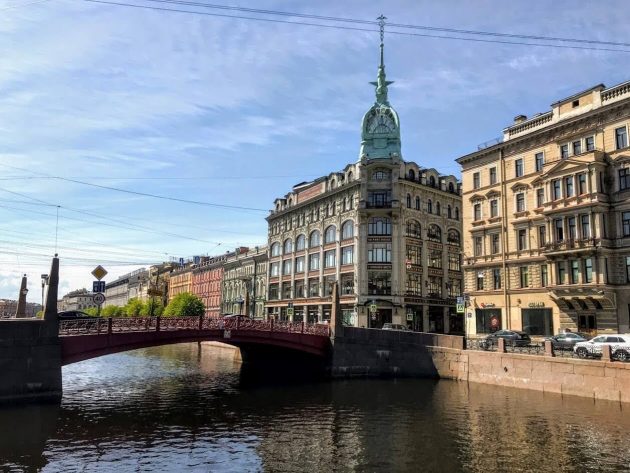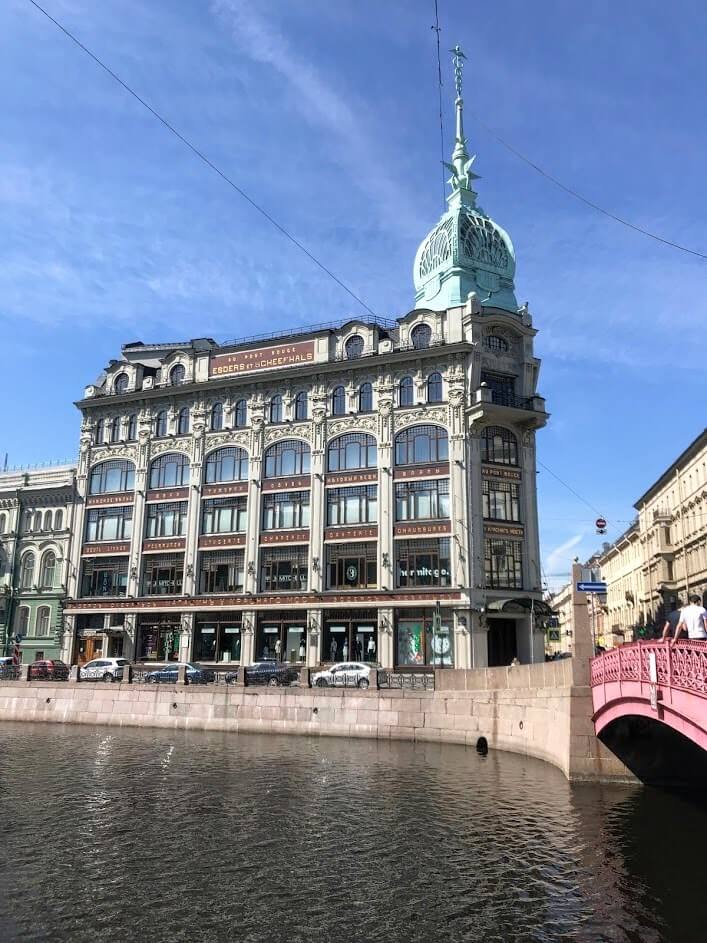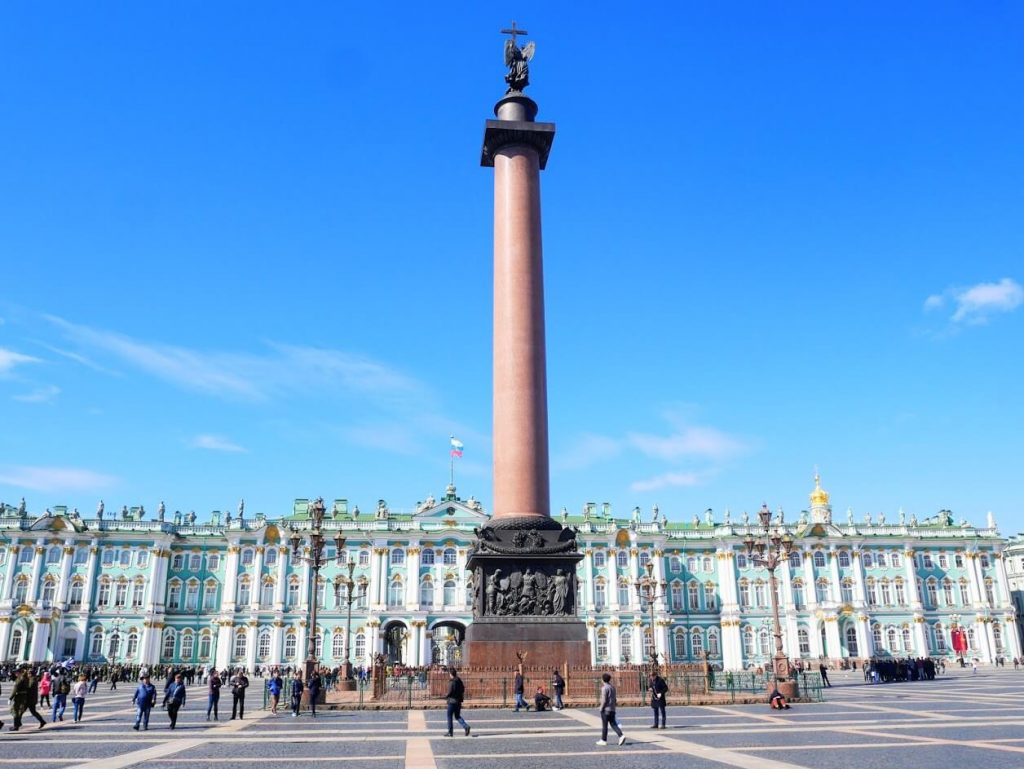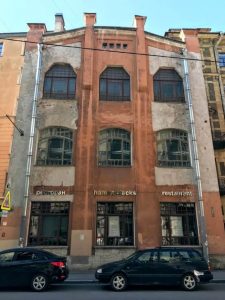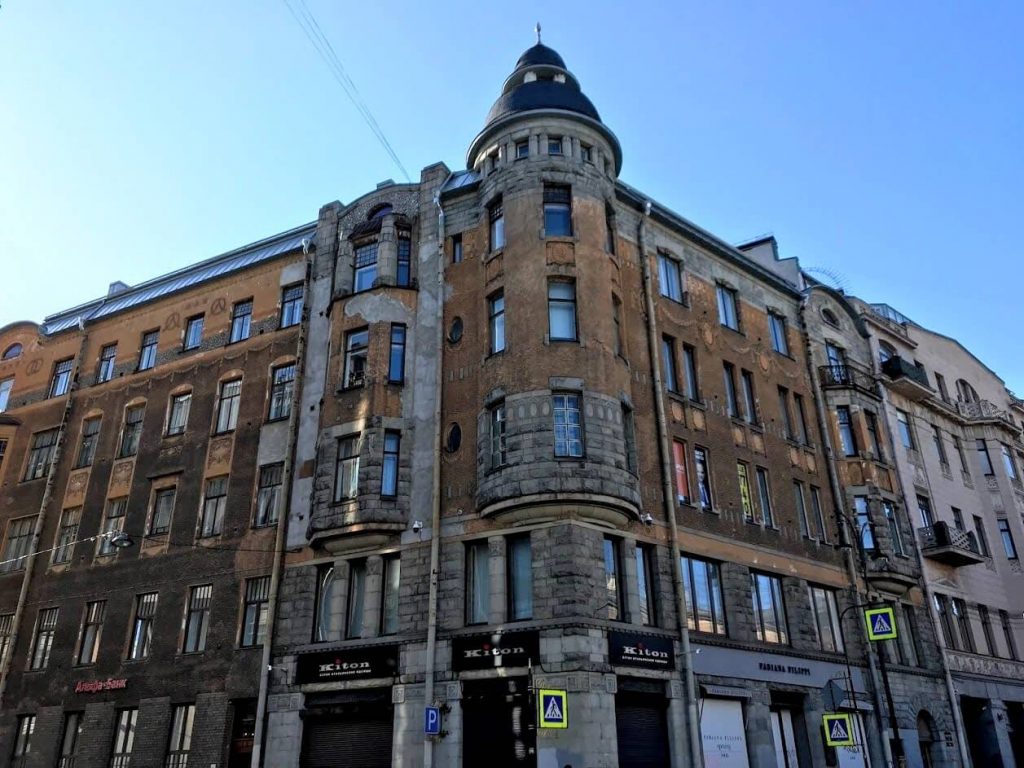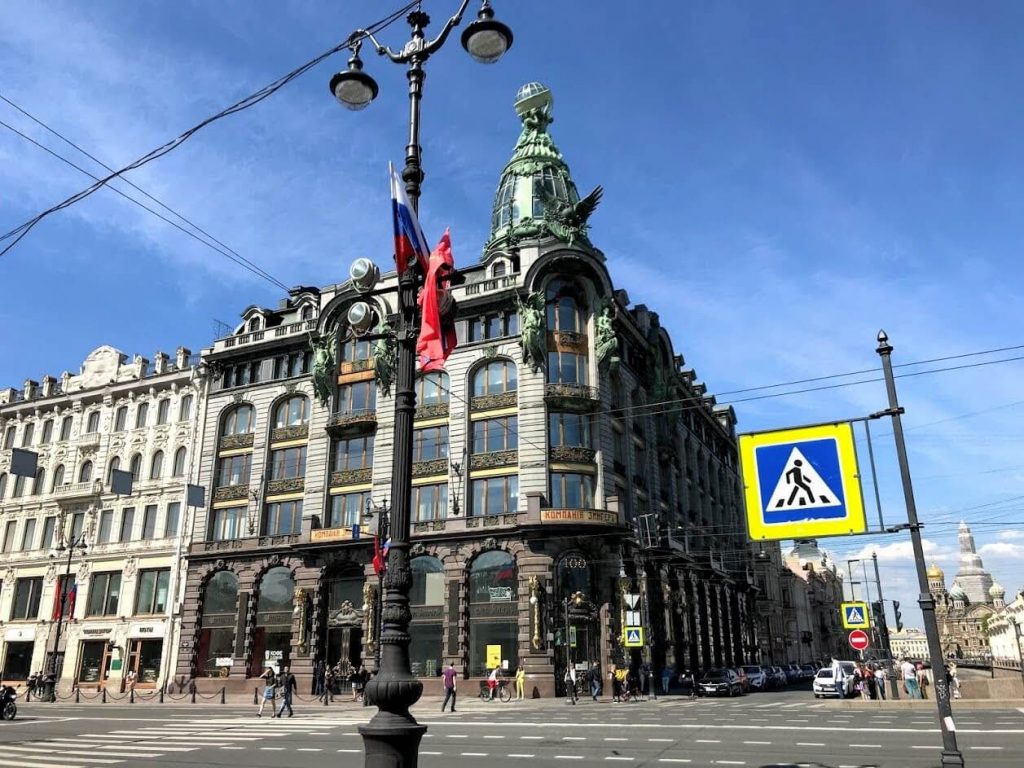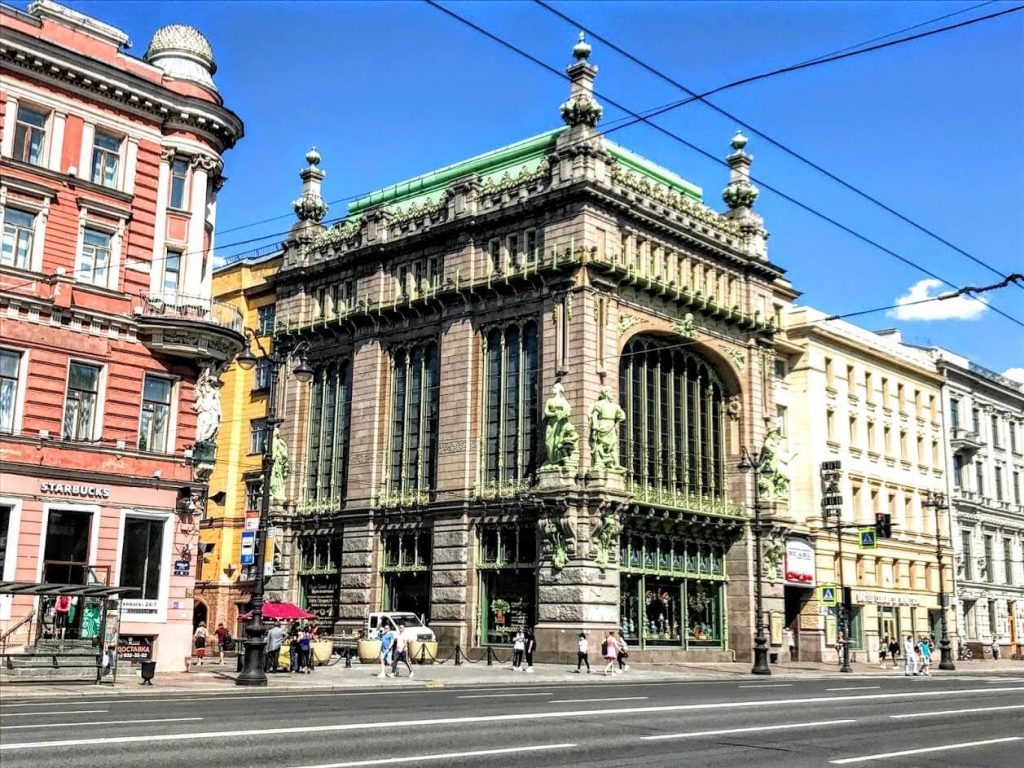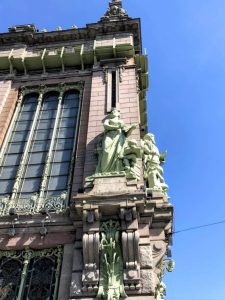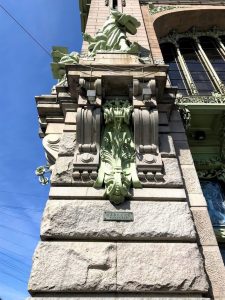Here are some good news for all Art Nouveau admirers! That spectacular architectural style is well represented in Saint Petersburg. And you can spend weeks studying its finest examples in the city and its surroundings. Today we’re taking you to an exciting virtual walk along the main avenue of the city, Nevsky Prospect. This is where you can find some of the earliest and best examples of Art Nouveau in Saint Petersburg.
Art Nouveau in Saint Petersburg
This is a guest blog post created by Culture Tourist’s long-term contributors, Alexandra and Karina from Carusel Tours. After the history of Fabergé Eggs, places linked to Leo Tolstoy in Moscow and exploring Saint Petersburg in the footsteps of Fyodor Dostoevsky, they prepared an interesting post about the Art Nouveau architecture in Saint Petersburg.
Art Nouveau architecture in Saint Petersburg should be on your must-see list when visiting this beautiful city. Well, let us show and tell you more about these miracles of architecture first.
⤷ TIP: You can freely get inside almost all of these buildings and appreciate their mesmerising interiors. They mostly house departments stores, bookstores and cafes today, so it’s easy to visit them.
Art Nouveau Walk around Nevsky Prospect
To help you find all of those Art Nouveau buildings in Saint Petersburg, check out the Art Nouveau Map on a link here.
Art Nouveau Stop 1: Palace Square
This Saint Petersburg Art Nouveau walk starts at the Palace Square, the main square of the city. When you are there, head towards the exit to the Moika River and cross the wide Green Bridge across it. Move towards Nevsky Avenue, and in a minute, you will reach Volynsky Lane.
⤷ TIP: Did you know that one of the rooms of the Winter Palace in the Hermitage Museum contains the original Art Nouveau Furniture of the Royal Family? Check it out during your visit to the most famous museum in Russia!
⤷ Read More: Visiting Hermitage Museum
Art Nouveau Stop 2: Volynsky Lane
This tiny lane is so rich on Art Nouveau! Its odd side is occupied with the back façade of DLT, the most famous department store built in the Art Nouveau style in the city.
On the left side of the lane, you’ll find two most beautiful examples of the Art Nouveau facades in Saint Petersburg. They are a wonderful example of regional adaptation of the Art Nouveau Style – the Northern Romantic Style.
*Art Nouveau House in 2 Volynsky Lane
The first one is a charming building with large Art Nouveau windows. The stucco moulding on the building has been falling apart for many years, but it is one of the details of the St. Petersburg style.
This is the former Printing House of A. Suvorin, erected in 1905 by the design of P. Makarov. In the Soviet time, it housed watchmakers. Today, it’s home to one of the most popular city restaurants, Hamlet and Jacks. Another part of the building houses the small Museum of Printing (you can visit it by appointment).
⤷ TIP: Hamlet and Jacks Restaurant offer a mix of modern Russian and overseas cuisines. It’s a lovely place to take some break after the visit to the Hermitage.
*Art Nouveau House in 6-8 Volynsky Lane
The lengthy corner building on the same side of the street was constructed in 1904-1905 by the design of F. Lidval. He was one of the most famous Art Nouveau architects of Saint Petersburg. Lidval was strongly influenced by the Northern Romantic Style, a part of the Art Nouveau movement in the Scandinavian countries and Saint Petersburg.
Being Swedish himself, he must have found a lot of inspiration in the northern folklore. The façade is decorated with the granite. It was one of the most popular materials of the Northern Romantic Style.
This building won the second prize for the best façade in 1907. Before the revolution, it housed the Fiat Automobile Shop on the ground floor.
⤷ Read more: Northern Romantic Style in St. Petersburg.
Art Nouveau Stop 3: DLT
Address: 21-23 Bolshaya Konyushennaya Street
DLT is an abbreviation that stands for the House of Leningrad Trade. As you can guess, this name was given to the department store by the Soviets. And although this epoch has long been over, the name is still in use.
This was the first building in Russia constructed with such a huge monolithic reinforced concrete frame. And one of the first modern department stores.
It was built with the money provided by the Guard Economic Society, that consisted of guard and navy officers. The first part of the department store was designed by E. Wirrich and completed in 1909. It was built in a record time, which was possible thanks to the use of the reinforced concrete frame.
The department store quickly gained popularity, as it offered competitive prices, and lots of smaller shops on the same street were forced to shut their businesses. All the guard and navy officers enjoyed great discounts there.
In 1912-1913 due to its great success, the second part of the building was constructed, and the department store increased in size.
In the 1930s, it became the leading Torgsin Store in the city. Here the locals and foreigners could buy deficit goods for foreign currency, gold, silver or precious stones. Torgsin is another Soviet abbreviation that stands for ‘trade with foreigners’.
⤷ Read more: Moscow of Bulgakov
During World War II the building was severely damaged, and it took three years to be completely restored. Starting from the 1960s and up to the 2000s, the department store specialised in goods for children.
After the recent and quite timely reconstruction, it was re-opened as the department store with upscale brands, and it has been very popular with foreign visitors of the city since then.
Feel free to get inside – it has a café and various holiday fairs and live music events traditionally often take place in the main hall.
Art Nouveau Stop 4: Au Pont Rouge or Red Bridge Department Store
Address: 73-79 Moika River Embankment
To see more of Art Nouveau architecture in Saint Petersburg, let’s return to the Moika River Embankment and stroll along it, crossing Nevsky Prospect. This area in the vicinity of the Winter Palace, the former royal residence, was one of the most aristocratic parts of the city. Our next stop is another brilliant example of an Art Nouveau department store in Saint Petersburg.
It is situated just across the Red Bridge on the Moika River, hence its name – Au Pont Rouge, which means ‘across the Red Bridge’ in French. Its owners were Dutch and Belgian entrepreneurs S. Esders and C. Scheefhals.
They had an empire of department stores across different European countries, but only a few buildings survived to our time. Our Au Pont Rouge is among them.
Why was it named in French?
It was the main international language at that time, and the nobility still used it heavily in their everyday life. By the way, among the clients of this store before the revolution were the members of the Russian Royal Family.
It was designed by V. Lipsky and K. De Rochefort and inaugurated in 1907. The whole building was constructed over the sturdy metal frame, just as was the case with DLT.
During the 1930s, its magnificent spire was demolished. But, it was returned during the recent reconstruction between 2009 and 2014.
In the Soviet Era, the former department store housed the textile factory. It became the department store for luxury goods in 2014 again.
⤷ TIP: Its Art Nouveau interior is well preserved. So, be sure to get inside and explore it, from entrance doors to old elevators.
Beautiful details on it are the signs on the sides of the buildings in old Russian and French. They were returned to the façades after the reconstruction. This is how many commercial buildings looked like before the revolution – they were covered with the same style signs with the names of the shops, cafes and services offered in them.
⤷ Read more: Saint Petersburg Travel Guide
Art Nouveau Stop 5: Singer House or The House of Book
Address: 28 Nevsky Prospect
To discover more of beautiful Art Nouveau architecture in Saint Petersburg, we’ll stroll along the Moika River Embankment and head back to Nevsky Prospect. There, we will turn right and, in a few minutes, we will stop in front of the Kazan Cathedral, which is just opposite to our next point of interest.
This landmark building was finished in 1904, and it is one of the earliest examples of Art Nouveau in Saint Petersburg. One can spend hours studying the intricate details on its façade and its interiors.
It was designed by P. Suzor as the main office of the Singer Corporation in Russia. The project was innovative in many senses – from engineering solutions, that embraced the best that Art Nouveau could offer, to its magnificent crystal dome decorated with bronze Valkyries and a transparent globe.
Although now it’s one of the symbols of the city, when it was constructed, many locals were shocked by it – they haven’t been used to the new style yet.
It was the first building in the Russian Empire constructed with the use of metal frames. The Singer Company wanted Suzor to build the tallest building on Nevsky Avenue for them.
But, at that time, it was forbidden to build facades of the houses higher than that of the Winter Palace. And their decorative towers should not have been hiding the cupolas of nearby churches.
Suzor came up with a brilliant solution – the building itself was not higher than the Winter Palace. Still, with the glass tower on its top, it was nevertheless exceeding the height of the palace. Thus, his clients could consider it to be the tallest building on Nevsky in a way.
At the same time, the light and transparent structure of the dome did not block the view of neither the Kazan Cathedral nor the Church on the Spilled Blood, inaugurated the same year.
Every local in the city has visited this house on numerous occasions. Since the Soviet times, it has been home to the largest bookstore in Saint Petersburg – The House of Book. And now, it’s also home to a nice café on the second floor.
You can enjoy wonderful views of the main city avenue from there. Many original interior details were preserved during the recent reconstruction, and you can see them when you are inside.
From time to time, you can also get on the roof of Singer House and learn more about its history and design with a special tour.
⤷ TIP: You can contact Alexandra and Karina from Carusel Tours and see if they could organise it for you.
There are so many fantastic details on the building. One of the Valkyries on the Singer House façade holds a sewing machine, the primary source of income of the Singer Company, in her hands.
There is also a huge bronze eagle on the dome. It’s the symbol of the United States, and it was mounted on the building during the First World War.
Anti-German moods were strong in the city during that time, and the Singer corporation wanted to highlight that they were actually an American company.
⤷ Read more: Visiting Peterhof Palace from Saint Petersburg
Art Nouveau Stop 6: Eliseyev Emporium
Address: 56 Nevsky Prospect
This magnificent Art Nouveau building in Saint Petersburg had its own theatre and was built by the Eliseyev Brothers. They were famous Russian merchants who made a fortune on gourmet food.
Brothers were the leading food suppliers of the royal family and wealthy people. As merchants, they eagerly supported new art movements – that was actually a shared characteristic of many Russian merchants.
It was merchants who brought Art Nouveau to the Russian Empire – they started with their own mansions and moved on to their commercial premises.
This building was designed by G. Baranovsky and inaugurated in 1903. It was one of the first architectural examples of Art Nouveau in Saint Petersburg. It was opened to house the gourmet food hall and wine cellars of Eliseyevs. It also had its own theatre and a branch of Russian-Chinese bank in the yard.
The allegorical figures that decorate its façades were created by A. Adamson, who is also the author of the sculptures on the Singer House.
The whole building rests on eight massive pylons that support all the inner ceilings. Its magnificent interiors that represent Art Nouveau in all its splendour with curvaceous lamps, stalls and stained glass windows are well preserved. You can marvel at them during your visit to the Eliseyev Food Shop on the ground floor!
Of course, the descendants of merchants Eliseyevs do not possess it anymore, but at least it regained their name. And the theatre in the building is still functioning – now it is the Comedy Theatre of Akimov.
The exterior and interior of the building blew the minds of the locals. Those who recovered from the initial shock came back with indignant reviews – it seemed that this building gathered all the negative epithets that could appear in the newspapers of that time.
You could read here only about a small part of the Art Nouveau heritage in Saint Petersburg. There are many more Art Nouveau buildings in Saint Petersburg, on Nevsky and adjacent streets.
But we got you introduced to the main commercial buildings of the city constructed in that style. We hope that this virtual walk will inspire you to come to Saint Petersburg and visit these miracles of engineering thought in person!
Many thanks to Alexandra and Karina for this wonderful guest blog post about the Art Nouveau architecture in Saint Petersburg.

